Information systemsâ
Download as pptx, pdf0 likes267 views
The document outlines the key components of an information system, including data, people, hardware, software, and telecommunications. It discusses each component in more detail, emphasizing that an information system is only as good as the quality of the data input, and that people play an important role in ensuring high quality input and output. The document also examines the input, storage, processing, output, and feedback loops that are fundamental parts of how information systems function.
1 of 14
Download to read offline
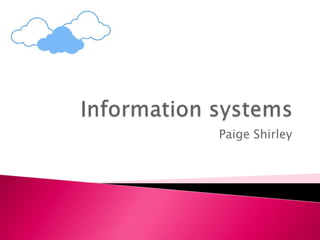
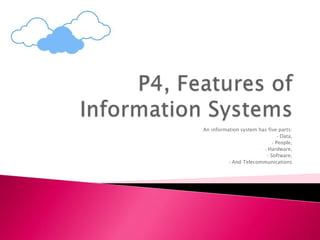
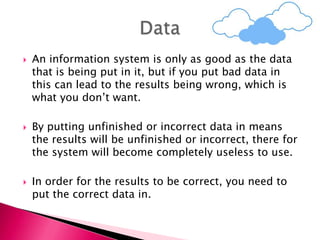

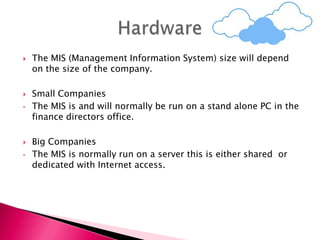
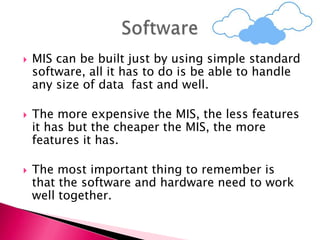
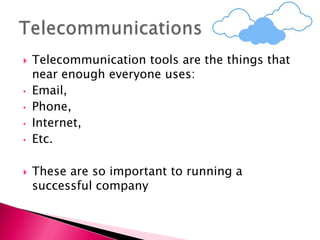
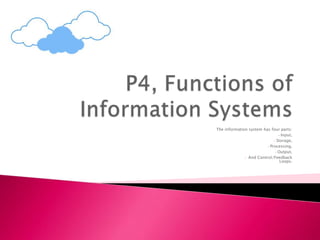
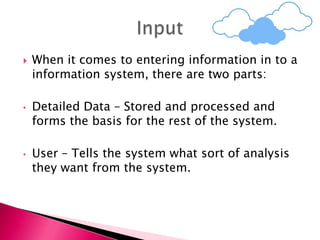
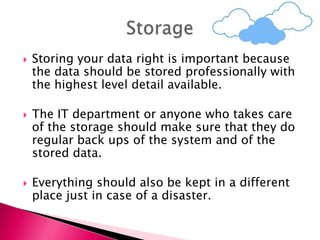

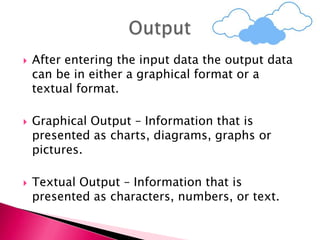

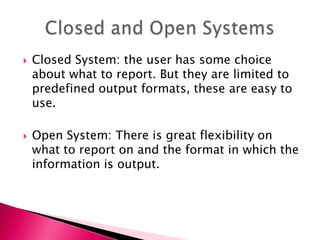
Ad
Recommended
Introduction to information system
Introduction to information systemAndino Maseleno
Ėý
This document provides an introduction to information systems. It defines key concepts like data, information, knowledge, and the difference between them. It also describes the different types of information systems, including transaction processing systems, management information systems, executive information systems, decision support systems, and office information systems. The document outlines the five basic components of an information system as hardware, software, data, processes, and human users. It provides examples of both manual and computerized information systems.Mis intro
Mis introsuhasan
Ėý
This document discusses information systems and how data is manipulated into useful information. It defines key terms like data, information, and systems. It also explains how computer-based information systems take in data, process it, and output information. Additionally, it describes the benefits of human-computer synergy and how information systems help with managerial problem solving and decision making. Finally, it outlines common information systems careers and how computer literacy is increasingly important for participation in modern society.information system
information systemparijatnath1990
Ėý
Information systems are comprised of interrelated hardware, software, data, procedures, and people that collect, process, store, and distribute information to meet organizational objectives. Organizations implement information systems to increase efficiency, support management, gain competitive advantages, and achieve long-term goals. Information systems development involves feasibility studies, systems investigation, analysis, design, implementation, and maintenance. Common types of information systems include operational support systems like transaction processing systems and management support systems such as management information systems, decision support systems, and executive information systems.Management Information System
Management Information SystemJo Balucanag - Bitonio
Ėý
The document discusses classic management functions, components of a management information system (MIS), and how information and communication technologies relate to management. It describes the five classic management functions as planning, organizing, staffing, directing, and controlling. It explains that an MIS takes data as input, processes it, and produces useful information as output using computer-based systems. It also discusses how information systems help managers focus on goals and operations by taking a systems thinking approach.information system introduction
information system introductionARSHIYA KHAN
Ėý
This document provides an overview of information systems. It defines an information system as a combination of hardware, software, and personnel that facilitates planning, control, and decision making in an organization. The document then describes several types of information systems, including management information systems, transaction processing systems, decision support systems, executive information systems, expert systems, and office information systems. It explains the necessity of information systems for controlling records, reducing costs, improving efficiency, and supporting management decision making. Finally, the document outlines some key roles and importance of effective management information systems.Information system
Information system AyushiDubey19
Ėý
This document discusses information systems and information system planning. It defines an information system as a collection of components that collect, process, store and provide output to complete business tasks. It then describes information system architecture as a conceptual blueprint that expresses the desired future structure of an organization's information systems. The document also discusses information engineering methodology, which uses a top-down approach to build data and process models. Finally, it notes the importance of information system planning at the enterprise level to support enterprise-wide computing through an information systems architecture.BTEC National in ICT: Unit 3 - Operational Issues
BTEC National in ICT: Unit 3 - Operational Issuesmrcox
Ėý
The document discusses several operational issues related to information systems including security, backups, health and safety, organization policies, business continuity planning, costs, and the increasing sophistication of modern systems. Key points include the need to dictate secure access to data, regularly back up information, follow appropriate ergonomic practices, manage costs through a business case, and provide more training as systems become more complex.Information systemspresentationfinal
Information systemspresentationfinalMis Nounou
Ėý
1) An information system is a set of interrelated components that collect, process, store, and disseminate data and information to meet an objective.
2) Information systems can be classified as either operations support systems, which process data from business operations, or management support systems, which provide information to support managerial decision making.
3) Key types of information systems include transaction processing systems, process control systems, office automation systems, management information systems, decision support systems, and executive information systems.Transaction processing system
Transaction processing systemanjana1994
Ėý
A transaction processing system (TPS) collects, stores, modifies, and retrieves data about business transactions. It must pass the ACID test, ensuring atomicity, consistency, isolation, and durability of transactions. There are two types - batch processing, where data is collected and processed periodically, and real-time processing, where data is processed immediately. The transaction processing cycle involves data entry, processing transactions, maintaining databases, generating documents and reports, and allowing for inquiries. The overall purpose is to keep records of the organization, process transactions that affect those records, and produce reports.BTEC National in ICT: Unit 3 - Ethical Issues
BTEC National in ICT: Unit 3 - Ethical Issuesmrcox
Ėý
Many organizations have codes of practice that define acceptable uses of computing facilities, with the main use being to support the organization's purpose. These codes often permit limited personal use and ban threatening emails or spam. They also restrict access to inappropriate websites and control web server content, while protecting employees who report other users' misuse. Organizational policies state how information is treated, such as restricting access to authorized personnel only, and data ownership lies with the departments that produce it, not the IT department that sets up systems.Good or bad
Good or badBunsyou Kou
Ėý
ERP (Enterprise Resource Planning) systems integrate information across key business functions like finance, manufacturing, sales, customer management. ERP software automates these functions and allows information to flow seamlessly between departments and external partners. ERP systems typically use a common database, run in real-time on integrated applications, and provide a consistent experience across modules without complex IT integration requirements.Introduction to mis
Introduction to misSJAYALAKSHMISARAN
Ėý
Management Information System (MIS) is a formal method to collect timely and accurate data from internal and external sources and transform it into useful information for decision makers. An MIS uses computer systems to gather, store, and analyze data, then distribute reports in standard formats to various levels of management. It consists of four major components: data gathering, data entry, data transformation through software, and information utilization for organizational decisions. Common types of MIS include Transaction Processing Systems, Decision Support Systems, Executive Information Systems, Marketing Information Systems, and Office Automation Systems. The primary objective of an MIS is to analyze other systems dealing with operational activities in an organization and support management planning and control.1.2) Information systems in context
1.2) Information systems in contextctedds
Ėý
An information system is composed of elements that work together to achieve a purpose. It performs information processes requiring participants, data/information, and information technology. The relationships between these elements are shown in a figure. An information system addresses the needs of individuals or groups and is influenced by its environment. It uses tools like hardware, software, and participants to input, process, store, output, and control data and information.Bridging the Data Divide: Using Automation to Unify Data Sources for Sustaina...
Bridging the Data Divide: Using Automation to Unify Data Sources for Sustaina...Urjanet
Ėý
The document discusses how automation can bridge the data divide for sustainability reporting, highlighting challenges faced by corporate sustainability teams in accessing accurate data from various internal and external sources. It emphasizes the complexities of managing disparate data formats from utility bills and suggests a streamlined approach using the Urjanet platform for data retrieval and integration. Automation is proposed as a solution to reduce labor-intensive processes and improve data quality for better reporting outcomes.Executive support system
Executive support systemDr. Vardhan choubey
Ėý
An Executive Support System (ESS) is software that analyzes enterprise data and presents it to executives in accessible reports. This helps executives make decisions by streamlining access to key performance indicators from across departments. Rather than manually compiling spreadsheets, an ESS integrates data, detects patterns, and alerts executives to opportunities or problems. When an ESS is not used, executives have to manually gather and analyze information from different sources to make reactive decisions, whereas an ESS supports proactive decision-making.Systems concept
Systems conceptSimran Kaur
Ėý
The document discusses systems analysis and different types of systems. It provides definitions of key terms like system, organization, interaction, and feedback. It describes different types of systems such as physical, abstract, open, and closed systems. It also discusses information systems like decision support systems, management information systems, and data processing systems. The document outlines the stages of the systems development life cycle including planning, requirements, design, development, testing, implementation, and maintenance.System concept in MIS
System concept in MISMohammed Jasir PV
Ėý
This document discusses systems concepts in management information systems. It defines a system as an orderly grouping of interdependent components working together according to a plan to achieve a specific objective. A system has inputs, processes, outputs, and feedback/control mechanisms. It also has boundaries and interacts with its environment. The document describes different types of systems including closed/open, deterministic/probabilistic, human/machine, adaptive/non-adaptive, simple/complex, and abstract/concrete systems. It provides examples of systems like an educational institution and a manufacturing plant.Introduction to MIS (Evolution of MIS)
Introduction to MIS (Evolution of MIS)Mohammed Jasir PV
Ėý
The document discusses the evolution of management information systems (MIS). It describes how MIS have developed from early office automation systems used to support clerical workers, to modern systems that provide computer-based support for complex decision making. The key components of an information system are outlined as hardware, software, databases, networks, and human resources. Transaction processing systems record daily transactions, while management information systems guide tactical decisions and decision support systems aid strategic decision making by top managers.Executive information system ( eis )
Executive information system ( eis )Puja Dhakal
Ėý
An executive information system (EIS) provides senior executives with easy access to internal and external information relevant to organizational goals through graphical displays and reporting capabilities. EIS emerged in the 1970s as mainframe-based programs and were early adopted by large firms seeking competitive advantage. EIS applications include monitoring company performance, identifying opportunities, analyzing competitors, and supporting executive planning, decision-making, and control responsibilities.Control in Systems - Feedback and Input, Process & Output Control
Control in Systems - Feedback and Input, Process & Output ControlMohammed Jasir PV
Ėý
The document discusses the role of feedback in management information systems, detailing positive and negative feedback types. Positive feedback amplifies system output and can cause instability, while negative feedback reduces output, promoting system regulation and stability. It also covers input, process, and output controls, emphasizing their importance in data handling and system performance.Quality and value of information & Information overload
Quality and value of information & Information overloadMohammed Jasir PV
Ėý
The document discusses the quality and value of information in management information systems, emphasizing that effective decision-making relies on dimensions such as utility, satisfaction, error, and bias. It also covers the concept of information overload, which occurs when the volume of input exceeds processing capacity, leading to negative consequences like stress and delayed decision-making. Finally, it suggests strategies to manage information overload, including focusing on essential sources, summarizing data, filtering messages, drawing inferences, and routing information effectively.Syandes quiz 3
Syandes quiz 3kimberbano
Ėý
This document defines and provides examples of different types of information systems:
Transaction Processing Systems (TPS) process user requests by collecting, modifying, and retrieving data and are used in banks, credit cards, and airlines. Office Automation Systems (OAS) integrate software to manage information electronically and are used in offices. Knowledge Work Systems (KWS) support knowledge workers by organizing work information, and are used by companies to improve standards. Decision Support Systems (DSS) improve business decisions by gathering relevant information, and are used by companies compiling data to solve problems. Executive Support Systems (ESS) summarize data into reports and can predict future performance, for use by executive managers. Group Decision Support Systems (GDSS)Mobile Bill Management System - Project Proposal
Mobile Bill Management System - Project ProposalAnuja Herath
Ėý
The document describes a proposed Mobile Bill Management System for Expolanka Freight (Pvt) Ltd. It outlines the current problems with their manual system, including high human resource involvement, errors, and lack of remote access. The proposed solution will automate bill processing and validation, provide remote access and detailed reports, reduce data redundancy, and ease administration. The system will import raw data, manage user profiles, generate reports, and include an admin panel. The objectives are to replace the existing system efficiently and provide a new experience for the development team.Introduction to Management Information System
Introduction to Management Information Systemhuma sh
Ėý
This document provides an introduction to management information systems. It defines MIS as a system that processes data to provide information to management for decision-making. It discusses the three components of MIS: management, information, and system. Management uses the information, information is processed data, and a system is used to process the data into usable information. The document also provides definitions of management, information, and system.SYANDES Quiz#3
SYANDES Quiz#3Laurits Estabaya
Ėý
Transaction processing systems are used to record, store, process, and generate records for business transactions. There are two types: batch processing systems which store data without immediate processing, and real-time systems which immediately process and grant access to collected data. Examples include bank transaction systems and airline reservation systems.
Office automation systems integrate computer hardware and software to automate office functions like word processing, email, and accounting. Examples are email distribution systems and data management systems.
Knowledge work systems are used by knowledge workers like engineers and doctors to create and disseminate new information within an organization. Examples include CAD software and virtual reality systems.Syandes third quiz task 1 systemanalysisanddesgin syandes
Syandes third quiz task 1 systemanalysisanddesgin syandesKevin Jayme
Ėý
The document defines and provides examples of different types of information systems:
- Transaction Processing Systems (TPS) are used for business transactions and recording things like paychecks and invoices. Examples include ATMs and airline reservation systems.
- Office Automation Systems (OAS) collect, process, store and transmit electronic documents and data for office tasks. Examples include document management, optical character recognition, and customer relationship management systems.
- Knowledge Work Systems (KWS) help professionals like engineers and designers stay up to date on the latest knowledge. Examples include CAD/CAM systems and virtual reality modeling.Management Information System
Management Information SystemSabin Tamrakar
Ėý
An information system is composed of people and computers that processes information to help organizations survive and develop through motivation, teamwork, innovation, leadership and decision making. A management information system (MIS) provides managers tools to organize, evaluate and efficiently manage departments by providing past, present and predictive information through software that supports decision making, data resources, decision support, people management and project management. An MIS differs from regular information systems in that its primary objective is analyzing other systems dealing with operational activities and supporting management's planning and control functions.Unit V
Unit VRichaVerma50353
Ėý
This document discusses management systems and integration of applications. It defines management information systems and their goals of providing managers with information, enabling regular operations, and facilitating control, organization, and planning. It then discusses types of management systems like EDI, DSS, and EIS. The document outlines the components, advantages, and limitations of management systems. It defines application integration as unifying data across different applications used by a company. It discusses challenges and approaches to integrating applications, including point-to-point and service bus integration.Know the features and functions of information systems
Know the features and functions of information systemsRajesh Khadka
Ėý
The document outlines the significance of information systems in organizations, detailing their components like hardware, software, and data, and how they function to gather, process, store, and disseminate information. It explores various types of information systems, their features, and the processes involved in data input, processing, output, and feedback. Additionally, it discusses the differences between open and closed systems, as well as the transformation of data into meaningful information.Lesson 4
Lesson 4MrsNunn
Ėý
An information system manages an organization's daily operations and management. It consists of key elements like data, people, hardware, and software. Data is input by people and generated throughout the organization. The quality of the data affects the system's output. Hardware stores large volumes of data and software processes it efficiently. People also impact data quality through accurate input. Training helps ensure proper data capture and entry.More Related Content
What's hot (20)
Transaction processing system
Transaction processing systemanjana1994
Ėý
A transaction processing system (TPS) collects, stores, modifies, and retrieves data about business transactions. It must pass the ACID test, ensuring atomicity, consistency, isolation, and durability of transactions. There are two types - batch processing, where data is collected and processed periodically, and real-time processing, where data is processed immediately. The transaction processing cycle involves data entry, processing transactions, maintaining databases, generating documents and reports, and allowing for inquiries. The overall purpose is to keep records of the organization, process transactions that affect those records, and produce reports.BTEC National in ICT: Unit 3 - Ethical Issues
BTEC National in ICT: Unit 3 - Ethical Issuesmrcox
Ėý
Many organizations have codes of practice that define acceptable uses of computing facilities, with the main use being to support the organization's purpose. These codes often permit limited personal use and ban threatening emails or spam. They also restrict access to inappropriate websites and control web server content, while protecting employees who report other users' misuse. Organizational policies state how information is treated, such as restricting access to authorized personnel only, and data ownership lies with the departments that produce it, not the IT department that sets up systems.Good or bad
Good or badBunsyou Kou
Ėý
ERP (Enterprise Resource Planning) systems integrate information across key business functions like finance, manufacturing, sales, customer management. ERP software automates these functions and allows information to flow seamlessly between departments and external partners. ERP systems typically use a common database, run in real-time on integrated applications, and provide a consistent experience across modules without complex IT integration requirements.Introduction to mis
Introduction to misSJAYALAKSHMISARAN
Ėý
Management Information System (MIS) is a formal method to collect timely and accurate data from internal and external sources and transform it into useful information for decision makers. An MIS uses computer systems to gather, store, and analyze data, then distribute reports in standard formats to various levels of management. It consists of four major components: data gathering, data entry, data transformation through software, and information utilization for organizational decisions. Common types of MIS include Transaction Processing Systems, Decision Support Systems, Executive Information Systems, Marketing Information Systems, and Office Automation Systems. The primary objective of an MIS is to analyze other systems dealing with operational activities in an organization and support management planning and control.1.2) Information systems in context
1.2) Information systems in contextctedds
Ėý
An information system is composed of elements that work together to achieve a purpose. It performs information processes requiring participants, data/information, and information technology. The relationships between these elements are shown in a figure. An information system addresses the needs of individuals or groups and is influenced by its environment. It uses tools like hardware, software, and participants to input, process, store, output, and control data and information.Bridging the Data Divide: Using Automation to Unify Data Sources for Sustaina...
Bridging the Data Divide: Using Automation to Unify Data Sources for Sustaina...Urjanet
Ėý
The document discusses how automation can bridge the data divide for sustainability reporting, highlighting challenges faced by corporate sustainability teams in accessing accurate data from various internal and external sources. It emphasizes the complexities of managing disparate data formats from utility bills and suggests a streamlined approach using the Urjanet platform for data retrieval and integration. Automation is proposed as a solution to reduce labor-intensive processes and improve data quality for better reporting outcomes.Executive support system
Executive support systemDr. Vardhan choubey
Ėý
An Executive Support System (ESS) is software that analyzes enterprise data and presents it to executives in accessible reports. This helps executives make decisions by streamlining access to key performance indicators from across departments. Rather than manually compiling spreadsheets, an ESS integrates data, detects patterns, and alerts executives to opportunities or problems. When an ESS is not used, executives have to manually gather and analyze information from different sources to make reactive decisions, whereas an ESS supports proactive decision-making.Systems concept
Systems conceptSimran Kaur
Ėý
The document discusses systems analysis and different types of systems. It provides definitions of key terms like system, organization, interaction, and feedback. It describes different types of systems such as physical, abstract, open, and closed systems. It also discusses information systems like decision support systems, management information systems, and data processing systems. The document outlines the stages of the systems development life cycle including planning, requirements, design, development, testing, implementation, and maintenance.System concept in MIS
System concept in MISMohammed Jasir PV
Ėý
This document discusses systems concepts in management information systems. It defines a system as an orderly grouping of interdependent components working together according to a plan to achieve a specific objective. A system has inputs, processes, outputs, and feedback/control mechanisms. It also has boundaries and interacts with its environment. The document describes different types of systems including closed/open, deterministic/probabilistic, human/machine, adaptive/non-adaptive, simple/complex, and abstract/concrete systems. It provides examples of systems like an educational institution and a manufacturing plant.Introduction to MIS (Evolution of MIS)
Introduction to MIS (Evolution of MIS)Mohammed Jasir PV
Ėý
The document discusses the evolution of management information systems (MIS). It describes how MIS have developed from early office automation systems used to support clerical workers, to modern systems that provide computer-based support for complex decision making. The key components of an information system are outlined as hardware, software, databases, networks, and human resources. Transaction processing systems record daily transactions, while management information systems guide tactical decisions and decision support systems aid strategic decision making by top managers.Executive information system ( eis )
Executive information system ( eis )Puja Dhakal
Ėý
An executive information system (EIS) provides senior executives with easy access to internal and external information relevant to organizational goals through graphical displays and reporting capabilities. EIS emerged in the 1970s as mainframe-based programs and were early adopted by large firms seeking competitive advantage. EIS applications include monitoring company performance, identifying opportunities, analyzing competitors, and supporting executive planning, decision-making, and control responsibilities.Control in Systems - Feedback and Input, Process & Output Control
Control in Systems - Feedback and Input, Process & Output ControlMohammed Jasir PV
Ėý
The document discusses the role of feedback in management information systems, detailing positive and negative feedback types. Positive feedback amplifies system output and can cause instability, while negative feedback reduces output, promoting system regulation and stability. It also covers input, process, and output controls, emphasizing their importance in data handling and system performance.Quality and value of information & Information overload
Quality and value of information & Information overloadMohammed Jasir PV
Ėý
The document discusses the quality and value of information in management information systems, emphasizing that effective decision-making relies on dimensions such as utility, satisfaction, error, and bias. It also covers the concept of information overload, which occurs when the volume of input exceeds processing capacity, leading to negative consequences like stress and delayed decision-making. Finally, it suggests strategies to manage information overload, including focusing on essential sources, summarizing data, filtering messages, drawing inferences, and routing information effectively.Syandes quiz 3
Syandes quiz 3kimberbano
Ėý
This document defines and provides examples of different types of information systems:
Transaction Processing Systems (TPS) process user requests by collecting, modifying, and retrieving data and are used in banks, credit cards, and airlines. Office Automation Systems (OAS) integrate software to manage information electronically and are used in offices. Knowledge Work Systems (KWS) support knowledge workers by organizing work information, and are used by companies to improve standards. Decision Support Systems (DSS) improve business decisions by gathering relevant information, and are used by companies compiling data to solve problems. Executive Support Systems (ESS) summarize data into reports and can predict future performance, for use by executive managers. Group Decision Support Systems (GDSS)Mobile Bill Management System - Project Proposal
Mobile Bill Management System - Project ProposalAnuja Herath
Ėý
The document describes a proposed Mobile Bill Management System for Expolanka Freight (Pvt) Ltd. It outlines the current problems with their manual system, including high human resource involvement, errors, and lack of remote access. The proposed solution will automate bill processing and validation, provide remote access and detailed reports, reduce data redundancy, and ease administration. The system will import raw data, manage user profiles, generate reports, and include an admin panel. The objectives are to replace the existing system efficiently and provide a new experience for the development team.Introduction to Management Information System
Introduction to Management Information Systemhuma sh
Ėý
This document provides an introduction to management information systems. It defines MIS as a system that processes data to provide information to management for decision-making. It discusses the three components of MIS: management, information, and system. Management uses the information, information is processed data, and a system is used to process the data into usable information. The document also provides definitions of management, information, and system.SYANDES Quiz#3
SYANDES Quiz#3Laurits Estabaya
Ėý
Transaction processing systems are used to record, store, process, and generate records for business transactions. There are two types: batch processing systems which store data without immediate processing, and real-time systems which immediately process and grant access to collected data. Examples include bank transaction systems and airline reservation systems.
Office automation systems integrate computer hardware and software to automate office functions like word processing, email, and accounting. Examples are email distribution systems and data management systems.
Knowledge work systems are used by knowledge workers like engineers and doctors to create and disseminate new information within an organization. Examples include CAD software and virtual reality systems.Syandes third quiz task 1 systemanalysisanddesgin syandes
Syandes third quiz task 1 systemanalysisanddesgin syandesKevin Jayme
Ėý
The document defines and provides examples of different types of information systems:
- Transaction Processing Systems (TPS) are used for business transactions and recording things like paychecks and invoices. Examples include ATMs and airline reservation systems.
- Office Automation Systems (OAS) collect, process, store and transmit electronic documents and data for office tasks. Examples include document management, optical character recognition, and customer relationship management systems.
- Knowledge Work Systems (KWS) help professionals like engineers and designers stay up to date on the latest knowledge. Examples include CAD/CAM systems and virtual reality modeling.Management Information System
Management Information SystemSabin Tamrakar
Ėý
An information system is composed of people and computers that processes information to help organizations survive and develop through motivation, teamwork, innovation, leadership and decision making. A management information system (MIS) provides managers tools to organize, evaluate and efficiently manage departments by providing past, present and predictive information through software that supports decision making, data resources, decision support, people management and project management. An MIS differs from regular information systems in that its primary objective is analyzing other systems dealing with operational activities and supporting management's planning and control functions.Unit V
Unit VRichaVerma50353
Ėý
This document discusses management systems and integration of applications. It defines management information systems and their goals of providing managers with information, enabling regular operations, and facilitating control, organization, and planning. It then discusses types of management systems like EDI, DSS, and EIS. The document outlines the components, advantages, and limitations of management systems. It defines application integration as unifying data across different applications used by a company. It discusses challenges and approaches to integrating applications, including point-to-point and service bus integration.Similar to Information systemsâ (20)
Know the features and functions of information systems
Know the features and functions of information systemsRajesh Khadka
Ėý
The document outlines the significance of information systems in organizations, detailing their components like hardware, software, and data, and how they function to gather, process, store, and disseminate information. It explores various types of information systems, their features, and the processes involved in data input, processing, output, and feedback. Additionally, it discusses the differences between open and closed systems, as well as the transformation of data into meaningful information.Lesson 4
Lesson 4MrsNunn
Ėý
An information system manages an organization's daily operations and management. It consists of key elements like data, people, hardware, and software. Data is input by people and generated throughout the organization. The quality of the data affects the system's output. Hardware stores large volumes of data and software processes it efficiently. People also impact data quality through accurate input. Training helps ensure proper data capture and entry.Lesson 4
Lesson 4MrsNunn
Ėý
An information system manages an organization's daily operations and management. It consists of key elements like data, people, hardware, and software. Data must be of good quality for accurate outputs. People input data and can affect quality. Hardware stores large volumes of data and software processes it efficiently. The system relies on coordination between these elements.1st know the features & functions of information systems
1st know the features & functions of information systemsBronte666
Ėý
This document discusses the key features and functions of information systems. It describes the components of an information system including data, people, hardware, software, and telecommunications. It then explains the functions of input, storage, processing, and output. Information systems can be either closed systems with predefined outputs or open systems that provide more flexibility in output formats.BTEC National in ICT: Unit 3 - MIS Features and Functions
BTEC National in ICT: Unit 3 - MIS Features and Functionsmrcox
Ėý
An information system has four main functions: input, storage, processing, and output. There is often a feedback loop so the system output can affect future input. An information system takes in detailed data through input, stores and processes it, and produces output information. The output can then provide feedback to users to influence future inputs into the system and analyses requested. Key elements that make up an information system include data, people, hardware, software, and telecommunications infrastructure.Ch1-Introduction to Management Information System .pdf
Ch1-Introduction to Management Information System .pdfetebarkhmichale
Ėý
The document introduces Management Information Systems (MIS), emphasizing the distinction between raw data and meaningful information, which supports decision-making. It outlines the components of an information system, including hardware, software, data, people, and processes, and explains how MIS aids in collecting, processing, and generating reports to enhance operational efficiency. Additionally, it discusses the various subsystems within MIS that align with organizational functions and activities, and the importance of both technical and behavioral approaches in information systems.FY bms ch1.pptx INFORMATION TECHNOLOGY IN BUSINESS MANAGEMENT
FY bms ch1.pptx INFORMATION TECHNOLOGY IN BUSINESS MANAGEMENTpushkarpssingh
Ėý
The document discusses the role of information technology in business management, covering essential concepts such as data, databases, management information systems (MIS), decision support systems (DSS), and executive information systems (EIS). It emphasizes the characteristics of information, such as accuracy, timeliness, and accessibility, and highlights the advantages of IT, including improved efficiency, remote access, and enhanced customer relationship management. Additionally, it touches on technologies like knowledge management systems, enterprise resource planning (ERP), expert systems, and open-source software, illustrating their impact on organizational effectiveness and decision-making.system analysis and design, data, information and system
system analysis and design, data, information and systemefuye
Ėý
The document discusses the distinctions between data and information in the context of system analysis and design, emphasizing the types of information required at various management levels and organizational functions. It defines systems, their characteristics, and types, explaining the roles of formal and informal information systems as well as the varieties of computer-based information systems like BDP, MIS, and DSS. The text further outlines the importance of quality information, system components, and processing techniques in ensuring efficient organizational operations.Information system management
Information system managementMutawakil Isse
Ėý
This document discusses key concepts related to information systems including:
- Data refers to raw facts without meaning, while information is processed data used for decision making.
- An information system consists of interrelated hardware, software, data, people and procedures working together to support organizational needs.
- Major types of information systems are transaction processing, management information, decision support, and executive support systems.
- Characteristics of effective information systems include being accessible, accurate, simple, flexible and secure.
- Managers at different levels utilize information systems for strategic planning, management control, and operational control.SYBCA SEM 4 VNSGU INFORMATION SYSTEM.pdf
SYBCA SEM 4 VNSGU INFORMATION SYSTEM.pdfSTUDY2BCA
Ėý
The document explains the distinction between data and information, defining data as raw, unprocessed facts while information is processed, organized data that has meaning. It highlights the importance of information for decision-making, outlining key characteristics such as quality, timeliness, completeness, and relevance. Additionally, it describes information systems, their components, and the difference between manual and computer-based systems.BIS-bit (1).pdf
BIS-bit (1).pdfwildguppyfam
Ėý
This document provides an overview of business information systems, including definitions of key concepts like data, information, knowledge, and the differences between them. It also describes different types of management information systems like transaction processing systems, decision support systems, group decision support systems, executive information systems, and expert systems. The document outlines the characteristics, components, benefits, and limitations of each type of information system.MIS Management Information Systems
MIS Management Information SystemsThomas Mon
Ėý
This document provides an overview of management information systems and computer systems. It defines key terms like data, information, and knowledge. It describes the basic components and operations of a computer system including input, processing, output, and storage. It also explains the differences between hardware, software, and different types of computers for individuals and organizations. Finally, it discusses information systems frameworks and components, and compares file-based systems to database approaches.Lo3=p4, p5, m2, d2
Lo3=p4, p5, m2, d2sparkeyrob
Ėý
This document discusses features and functions of different types of information systems. It provides examples of information systems used in various business environments like laboratories, schools, and organizations. Specific information systems discussed include Laboratory Information Management Systems (LIMS), School Information Management Systems (SIMS), Marketing Information Systems, Human Resource Information Systems, and Financial Information Systems. The document also covers purposes of information systems, data flow diagrams for a school SIMS and library booking system, and legal and ethical implications of input and output data.KMBN-208-MIS Notes-Uint-1st & 2nd.pptx
KMBN-208-MIS Notes-Uint-1st & 2nd.pptxSumit Kumar
Ėý
This document provides an overview of the Management Information Systems (MIS) course offered at Jagran Institute Of Management. The course objectives are to help students understand the importance of information management in business, different types of information systems, applying concepts through software, and understanding security and ethical issues. The course will be taught over 3 units covering MIS fundamentals, information and decision making, and database management. Students will learn concepts through both lectures and hands-on labs working with spreadsheet and database software.system analysis and design used in software
system analysis and design used in softwarenazimsattar
Ėý
The document provides an overview of systems analysis and design, defining key concepts such as systems, components, and the importance of understanding user needs. It discusses various types of systemsâincluding physical, abstract, open, and closed systemsâand their respective roles within organizations, particularly in information management. Additionally, the document elaborates on formal and informal information systems, decision support systems, and the principles for building successful systems.MIS-Uint-Ist, IInd & IIIrd.pptx
MIS-Uint-Ist, IInd & IIIrd.pptxSumit Kumar
Ėý
The document outlines an MBA course on Management Information Systems (MIS) at Jagran Institute of Management. It includes the course objectives, which are to help students understand the importance of information management in business, different types of information systems, applying concepts through software, and addressing security and ethical issues. The course units cover topics such as MIS needs and objectives, information technology trends, transaction processing systems, and managing data resources through database management systems. Suggested readings are also provided.DATABASE ALL CHAPTERS.pptx
DATABASE ALL CHAPTERS.pptxMAHERMOHAMED27
Ėý
The document outlines the fundamentals of databases, including definitions of data, information, knowledge, and the components and types of information systems. It explains the importance of data validation, methods to maintain data integrity, and the significance of validation rules in MS Access. Additionally, it covers queries, detailing their purpose, types, and how they can be used for data manipulation in a database.management information-system
management information-systemShahi Raz Akhtar
Ėý
The document discusses management information systems (MIS) which use computer hardware and software to collect, process, store, and disseminate information to support decision making and problem solving within an organization. An MIS manages information through acquiring, using, and discarding data efficiently. It also discusses the differences between data and information, skills required for MIS including computer and information literacy, and various computer-based information subsystems like accounting, management, and marketing information systems. Information specialists that support MIS are also outlined.Foundation Of Information System
Foundation Of Information SystemNirajan Silwal
Ėý
Data is collected from various sources and processed through different stages of the data lifecycle. It is then stored and can be accessed when needed before being destroyed. There are various types of data processing including batch, online, and real-time processing. Data is processed using manual, mechanical, or electronic methods and transformed into meaningful information through systems like transaction processing systems, management information systems, decision support systems, and executive information systems. These systems are interrelated and support different levels of management in organizations.Management information systems and cyber
Management information systems and cyberAnjali
Ėý
An information system evaluates, analyzes, and processes an organization's data to produce useful information for management decision making. A digital firm conducts nearly all business digitally through digital networks. The core components of an information system are hardware, software, data, networks, and people. Hardware provides computing power, software provides instructions, data is recorded business transactions, networks allow communication, and people are both users and specialists.Ad
More from Paige Shirley (7)
Functional areas
Functional areasPaige Shirley
Ėý
The document outlines the key functions within a business and their responsibilities. Finance is responsible for financial records, securing funding, and paying staff and suppliers. Human resources ensures the business has qualified staff, a safe work environment, and handles recruitment, retention, training and workplace policies. Customer service provides support to customers through information, advice, product delivery, and after-sales assistance.The project planning for my website
The project planning for my websitePaige Shirley
Ėý
The document outlines the planning process for creating a website. It describes creating moodboards, storyboards, and layouts to plan the site structure. A Gantt chart was used to schedule tasks, allocate timeframes, and ensure all aspects were completed. The planning process allocated 7 days for design, 16 days for development, and 6 days for testing. Storyboards, moodboards and layouts were created on paper and digitally. The website was built using Notepad++. Links, content, menus and pages were added before comprehensive testing and closing the project.Music aâs learning spreadsheets
Music aâs learning spreadsheetsPaige Shirley
Ėý
Spreadsheets are documents divided into rows and columns that are used to organize and calculate numerical data. They are used by engineers, bankers, supermarkets, teachers, and scientists to track finances, perform calculations, analyze results, and manage large amounts of information. Spreadsheets ease the process of working with numbers by automatically calculating totals, averages, and formulas.User guide to excel
User guide to excelPaige Shirley
Ėý
This document provides instructions for using Microsoft Excel. It explains how to open Excel, what spreadsheets are used for, how to enter and edit data in cells, common errors like disabled macros and how to fix them, and who to contact for help.How to stay safe on facebook! (3)
How to stay safe on facebook! (3)Paige Shirley
Ėý
Facebook allows users to connect with friends, share updates, and play games. It is important to set privacy settings to control who can see your posts, tag you in things, add you as a friend, and send you messages. Users should also be careful about oversharing personal information and use strong, unique passwords to stay safe online. The document provides steps for getting started on Facebook safely, including how to create an account, adjust privacy settings, block unwanted users, and manage app permissions.Damn i lost a life!!
Damn i lost a life!!Paige Shirley
Ėý
This document discusses different types of computer games. It describes various gaming platforms including consoles, PCs, handheld consoles, and mobile phones. It then lists and provides brief descriptions of common game genres such as action, role-playing, adventure, strategy, puzzle, simulation, sports, and educational games. Specific genres like combat, first-person shooter, and stealth shooter games are also mentioned. Examples of popular game consoles, handheld devices, and mobile games are provided.Electricity
ElectricityPaige Shirley
Ėý
Electricity is the flow of electrons and is a form of energy that powers many devices in modern life. It is measured in watts, with one watt being a small amount of power. While voltage pushes current through the body, it is the current or amps itself that can kill, as little as 50mA across the heart is enough to cause death. Computers require direct current to function which is obtained by converting alternating current from wall outlets. When working inside a computer, static electricity must be discharged to avoid damaging components, as they can be harmed by as little as 10 volts from static.Ad
Information systemsâ
- 2. An information system has five parts: âĒ Data, âĒ People, âĒ Hardware, âĒ Software, âĒ And Telecommunications
- 3. ï― An information system is only as good as the data that is being put in it, but if you put bad data in this can lead to the results being wrong, which is what you donât want. ï― By putting unfinished or incorrect data in means the results will be unfinished or incorrect, there for the system will become completely useless to use. ï― In order for the results to be correct, you need to put the correct data in.
- 4. ï― When it comes to who uses it and what for, there are many types of people who would use it for many reasons. ï― The main people to be involved with using it are the people who are involved in the capture, processing and the input of the data. ï― People can affect the quality of the output and the information system because if the data that is put in is wrong the system will become useless. ï― This means that the system is only as good as the expert it has been collected from
- 5. ï― The MIS (Management Information System) size will depend on the size of the company. ï― Small Companies âĒ The MIS is and will normally be run on a stand alone PC in the finance directors office. ï― Big Companies âĒ The MIS is normally run on a server this is either shared or dedicated with Internet access.
- 6. ï― MIS can be built just by using simple standard software, all it has to do is be able to handle any size of data fast and well. ï― The more expensive the MIS, the less features it has but the cheaper the MIS, the more features it has. ï― The most important thing to remember is that the software and hardware need to work well together.
- 7. ï― Telecommunication tools are the things that near enough everyone uses: âĒ Email, âĒ Phone, âĒ Internet, âĒ Etc. ï― These are so important to running a successful company
- 8. The information system has four parts: âĒ Input, âĒ Storage, âĒ Processing, âĒ Output, âĒ And Control/Feedback Loops.
- 9. ï― When it comes to entering information in to a information system, there are two parts: âĒ Detailed Data â Stored and processed and forms the basis for the rest of the system. âĒ User â Tells the system what sort of analysis they want from the system.
- 10. ï― Storing your data right is important because the data should be stored professionally with the highest level detail available. ï― The IT department or anyone who takes care of the storage should make sure that they do regular back ups of the system and of the stored data. ï― Everything should also be kept in a different place just in case of a disaster.
- 11. ï― Processing is what turns the data into information. ï― Processing at its simplest could just be adding up the prices of all of the things a person could buy on their weekly shopping list. ï― Processing at its most complex the computer can perform the complex calculations for example making assumptions about missing data.
- 12. ï― After entering the input data the output data can be in either a graphical format or a textual format. ï― Graphical Output â Information that is presented as charts, diagrams, graphs or pictures. ï― Textual Output â Information that is presented as characters, numbers, or text.
- 13. ï― Control or a feedback loop is what happens in the company as a result of the output from an information systems. ï― A example of it is a data feed of actual sales data to a computerised stock control system, this could note which products from suppliers have increasing sales and reorder these products in order to reduce the likelihood of being out of stock.
- 14. ï― Closed System: the user has some choice about what to report. But they are limited to predefined output formats, these are easy to use. ï― Open System: There is great flexibility on what to report on and the format in which the information is output.
